What Digital Transformation Means and How It Impacts You
In the past few years, the world has altered dramatically. COVID-19 and remote working has pushed businesses to adapt at a rapid pace, and digital transformation has taken center stage. While it isn’t new to organizations, its importance has grown – becoming critical to a company’s survival.
Digital transformation has traditionally been defined with technology at its core: the integration of artificial intelligence (AI), machine learning (ML), automation, data, and analytics within business. But a recent GetSmarter survey of 5,808 people from 128 countries found that innovation and change can’t just be defined as technical, it has to be human-centered too. If businesses – and specifically people – fail to prepare, their digital transformation initiatives are doomed to falter.
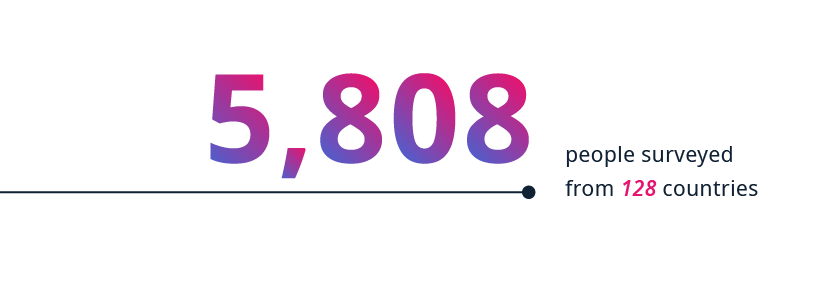
Despite digital’s essential place within the future of all organizations, individuals have struggled to feel the same rush to innovate. In part, it’s because professionals aren’t aligned on what, exactly, digital transformation means. Nor is there an understanding of how it impacts their work and careers. Digital transformation ignites agility and resilience not just in organizations, but in people too. Harnessed in the right way, it can help optimize skill sets in the same way as it reimagines businesses.
What is digital transformation?
Digital transformation in business has historically been defined as using technologies to create new – or optimize existing – processes, culture, and customer experiences.1 Technology is implemented to meet changing business and market needs, and to take a company into the digital future. Its adoption impacts the entire organization and requires revolutionary thinking and action. For many businesses, it’s a daunting initiative, but taking the digital leap has profound benefits for employees and customers.
There is no shared understanding
Perhaps because of its far-reaching influence on companies, industries, and roles, digital transformation has gathered many different interpretations over time. GetSmarter’s research – which sought insights from leaders, entrepreneurs, consultants, and C-suite executives – found that there’s not one unified, agreed upon definition of digital transformation. Or rather, that digital transformation means different things to different people.
The findings show that the most popular understandings are: the incorporation of digital technology into every domain of business, and the use of digital technology to help people find solutions to their problems. Our survey respondents also identified 19 other definitions.
If the meaning is unclear and its impact is misunderstood, businesses and professionals will fail to align on effective digital transformation roadmaps for the future.

Digitization and digitalization versus digital transformation
To add to the lack of a shared understanding, digital transformation also regularly gets confused with digitization and digitalization.
Digitization is when analog information is moved into a digital format. Digitalization uses digitization and technologies to establish digital processes. Digital transformation takes this one step further. It goes beyond singular digital initiatives. It’s a holistic approach that leverages technology to make business better for both employees and customers.2
Because digital transformation has two distinct parts to its success – people and technology – its understanding has similarly been divided. This pattern emerged in GetSmarter’s data when respondents were asked what digital transformation means to them.
From the professionals surveyed, 35% believe digital transformation is a people-centric change, and 32% think it’s a tech-driven change. For those who believe it’s people-led and technology-supported, digital transformation is:
- A change in how an organization delivers value to its customers
- A change in how an organization uses people and culture
- People utilizing technology to the best of its ability
For the respondents who believe it’s a technology-focused shift, digital transformation is:
- A change in how an organization uses technology
- Digitization: moving from analog to digital
- Replacing older technologies with newer technologies
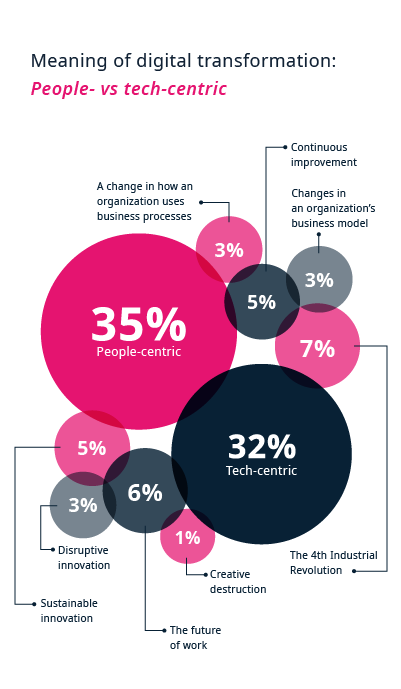
While none of these interpretations are wrong – as digital transformation is about both people and technology – having so many diverse opinions produces multiple business priorities and plans.
Why digital transformation strategies fail
It’s precisely because of the divergence in understanding that businesses fail to roll out their digital transformation frameworks successfully. Different interpretations lead to different goals among executives and managers, which breeds misalignment across functions and teams.
An individual’s understanding of digital transformation also shapes their conclusions on how it affects them, and what actions they need to take to respond to it. If everyone has a different understanding, then people will prepare, prioritize, and implement their strategies in separate ways.
The challenges of digital transformation are not only technology-based – they’re often with people. Or, as George Westerman from MIT says, “Digital transformation is less of a digital problem than it is a leadership problem.“3
The issues often lie within leadership and how leaders envision and drive change. If they are unaware of what digital transformation means and its effect on business, it will be difficult to champion it. Key company decision makers also need to effectively convey the need for change and ensure all employees understand and are prepared.
A shortfall in leadership capabilities, and delivering such comprehensive change at scale, are the biggest hurdles to effective transformation. It’s also difficult to get employees on board with digital transformation if priorities aren’t set and leadership’s vision and strategy is unclear.
Browse a selection of digital transformation courses for leaders from the world’s top universities and institutions.
Implementing digital into your day-to-day work requires a shift in skill set and in attitude. It can be difficult to remove such barriers to change, as it asks employees to reimagine the work and methods they’ve long known. Thus, it’s critical that leaders not only know how to deliver business success with digital transformation – they must also be able to support employees in understanding and implementing shifts in their daily tasks. This challenge highlights why change management and leadership is so key to the success of your digital transformation journey.
Digital transformation doesn’t have to have one set understanding – as the world around us changes, so will digital transformation. But from our GetSmarter research, it seems that the emerging interpretation is this:
Digital transformation focuses on the leveraging of technologies like cloud computing, AI, enterprise software, while harnessing human capital with change management, to achieve real business growth.
A digital transformation strategy, however, is going to be different for every business. You’ll need to identify what particular strategy will work for your company and stakeholders, and create a unique vision of how to achieve it.
Set yourself up for digital success
Explore GetSmarter’s portfolio of online digital transformation courses designed to help non-technical future thinkers develop effective transformation strategies, lead change, and achieve innovation in business.
The impact of digital transformation
Digital technologies such as AI, cloud services, advanced analytics, and the Internet of Things can redefine the way you, and your customers, engage with business. Technology paired with an effective business transformation strategy and skilled employees can help:
- Improve business agility and your response to market changes.
- Increase team collaboration through effective communication technologies.
- Achieve higher productivity levels by introducing AI and automation.
- Build remote teams using modern IT infrastructure and cloud storage.
- Design better customer experiences using data and analytics.
Transform your business into an innovative, efficient, and sustainable company of the future. No technical expertise needed.
Digital transformation can also bring a significant financial benefit. A 2021 McKinsey survey revealed that more than 75% of transformation initiatives yield cost reductions and improve the employee experience. Additionally, two-thirds of the survey respondents said that the efforts increased revenue from both existing and new revenue streams.5 But perhaps most importantly, the survey found that when companies changed their people and talent strategies and focused on upskilling employees, the greatest business transformation occurred.
Becoming digitally fluent has never been more critical. By adopting a digital transformation approach to not only business, but to your role and career too, you’ll achieve longevity across all three aspects. It’s now time for individuals to take note of the change happening around them, and transform in the same way as businesses.
Digital transformation affects organizations and individuals differently
Since its emergence, digital transformation has been viewed through the lens of businesses, industries, and economies. Because of this, there has been very little focus on how it impacts individuals. Businesses are now navigating the fact that digital transformation impacts each individual differently. Organizations are also realizing that they’ll need to respond to each employee’s level of resistance to change.
GetSmarter’s research found that when we asked what digital transformation means within specific business functions, each department’s answer was different. Executive leadership is more focused on delivering digital transformation that adds value to its customers and using digital technology to solve problems and create solutions. The information technology function understands digital transformation to be technology that gets used in every domain of business. And project management is more tech-centric and believes digital transformation to be a change in how organizations use technology.
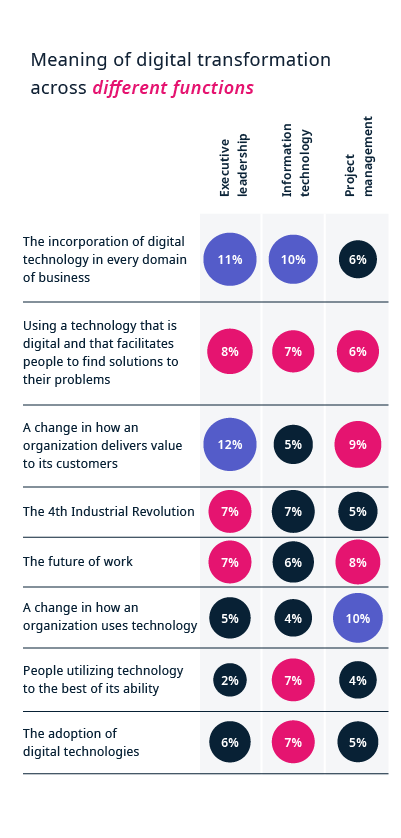
Each working individual also has a different understanding. CEOs, for instance, are focused on:
- Incorporating tech into the business.
- Delivering value to the customer.
- Disruptive innovation.
These interpretations again differ when we ask other levels within an organization.
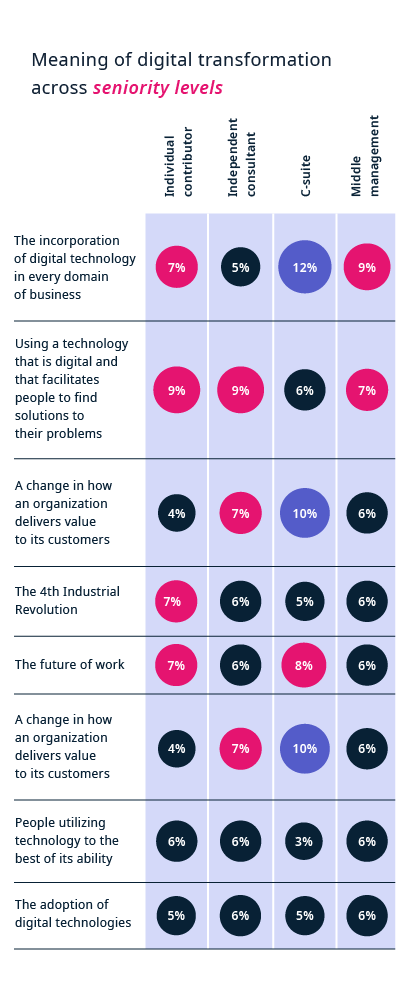
Different interpretations are only natural, as the way digital transformation impacts retail is entirely different to how it’s applied in manufacturing, finance, or marketing. The same goes for specific business functions and roles.
Whatever your particular understanding of digital transformation is, one thing should be recognized: people are critical to its implementation. In order for it to spread into every business domain and to improve the experience for customers and staff, organizations will first need to decide on what digital transformation means to them. Leaders will then need to ensure that this interpretation meets the business’s digital goals, is pervasive across business functions, and is upheld in each role. What sets real transformation apart is the ability to create employee buy-in and willingness to change.
Drive performance and increase your understanding of data and technology with this online certificate course from the London School of Economics and Political Science.
How generations react to automation and role displacement
There is another consequence of digital transformation for individuals: tasks and roles are becoming more digital. Yet, GetSmarter found that 49% of individuals aren’t concerned that their role may be automated or disrupted. This lack of concern may indicate a lack of awareness, when in fact, up to 11 million jobs may be claimed by automation in the next 10 years.6
GetSmarter’s data revealed that Generation Z is the most concerned about the ramifications of automation, and Baby Boomers are the least worried.
Additionally, junior and middle management fear job displacement, while senior- and executive-level professionals are less concerned.
Generation Z has been raised with technology, so this insight is surprising. This may result from the power dynamic between ages, but also from the types of roles these generations occupy and the types of skills required.
Older generations tend to be in more senior leadership roles and thus feel more job security. They aren’t as concerned about digital change because they commonly rely on their human-centric skills, such as leadership and analytical thinking. They’re also more aware that interpersonal skills are harder to replace. On the other hand Gen Zs, typically the least senior in an organization, largely rely on technical skills and digital capabilities – which are constantly changing and need continuous updating. They recognize that their role – or at least a part of their role – is the most at risk of being automated. Younger generations are also digital natives, and may understand the potential of technologies better than their older counterparts. Boomers are also closer to retirement, and so the impact of automation may not affect them. Essentially, it seems the more senior you are the less concerned you are about losing your role.
Despite these differences, professionals of all ages will need to prepare for digital transformation. Your learning path will depend on whether you’re leading the strategy, or rather providing the necessary technical skills to achieve change.
Where is change being felt?
COVID-19 drastically accelerated digital transformation.7 The majority of GetSmarter’s survey respondents – 66% – say a significant amount of disruption has occurred in their industry since the pandemic began. Yet despite 85% of CEOs increasing their number of digital initiatives, most can’t articulate their strategy or detail their progress beyond the fact that they made a tech investment.8
The lack of preparation – and confidence – points to the growing skills gap within leadership and change management in the digital age. What’s more, there seems to be a delay between oncoming disruption and actual change. Professionals are yet to feel the direct effect of technology transformation, but that’s not to say radical change isn’t occurring.
In GetSmarter’s 2020 The Future of Work Is Here report, technology was ranked as the biggest driver of change within business. When we examined where disruption is being felt within an organization in the last six to 12 months, our survey respondents ranked business processes as the most disrupted and an individual’s role as the least affected.
These insights align with our previous research, which found that job responsibilities won’t fall away entirely because of new technologies like AI and automation. Instead, only aspects of a role will change or become obsolete.
It’s time to adopt AI in business. Experience the solutions and advantages it brings, with an online course suited to your expertise.
So while businesses are adapting, the majority of actual jobs are not – yet. Coupled with the fact that automation won’t necessarily take away your job but rather alter it, it’s no wonder that professionals haven’t felt the same disruption as organizations have. But the change for individuals – at a granular task level – is still to come.
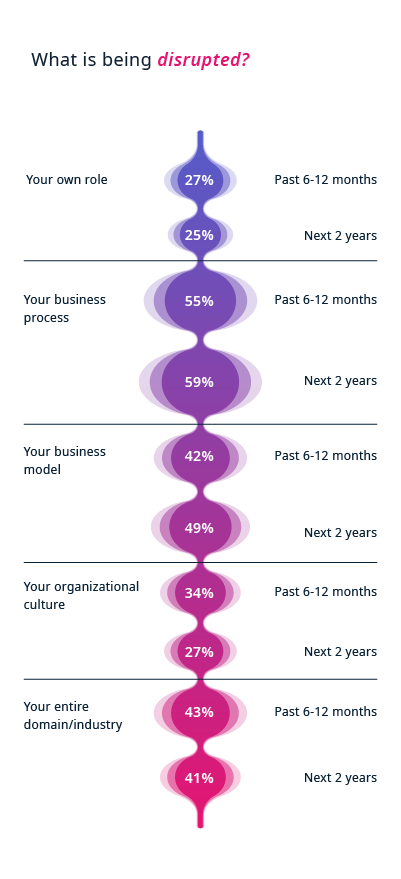
When we asked our respondents what parts of their business or industry have been most affected by digital transformation, they said:
- The integration of technology into systems and processes.
- Strategy and leadership.
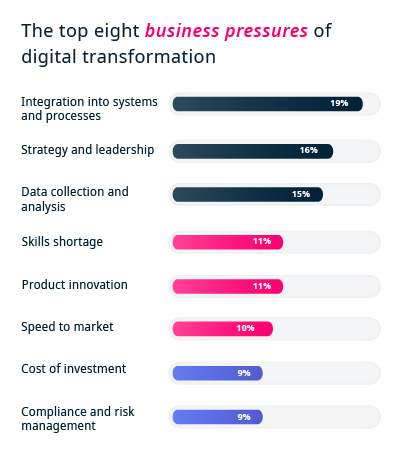
These pressure points are linked to the fact that businesses are struggling to create a unified, shared vision of what digital transformation should achieve and how it should be implemented. The graph also reiterates how essential leadership and strategy are to successful, sustainable digital transformation efforts – and reveals how interconnected each challenge is.
The struggle of integrating digital transformation into systems and processes speaks directly to how the focus of digital transformation has shifted – from understanding the technology to being able to manage and implement it within an organizational context. Legacy systems may be a key concern here as organizations struggle to integrate technology into established roles and functions while simultaneously adapting the culture of the organization. Another challenge is that older generations believe digital won’t impact their executive roles.
Digital transformation, however, requires absolute advocacy from the top down. Applying new systems and processes requires strong leadership and clear implementation strategies, as well as change management that creates employee (and management) buy-in.
With so much uncertainty, and without a clear understanding of a business’s digital future, the role of a digital leader is murky. The best digital transformation leaders have a clear plan for the future, with a resilient change management strategy in place to build and nurture a digital, agile workplace culture.
Prepare your business structures for a successful digital transition in this MIT Sloan online short course.
Your future growth
It’s clear, change is being felt by businesses and industries across the globe. So why aren’t you feeling a similar shift in your job?
Until now, the focus of digital transformation has been on technology. But as GetSmarter discovered, people are essential to making change happen. Companies have now started to acknowledge that their transformation efforts will be futile if the transformation hasn’t similarly extended to the workforce.
Real, impactful organizational change starts with the employee. You’ll be the one that manages the technology, interprets data insights, and drives a digital transformation strategy. This is why you need to start cultivating a mindset that understands technology’s role in your future. More importantly still, you need to realize that digital transformation is already affecting your short- and long-term career growth, which is why upskilling has become one of the most important considerations for the future.
In the second part of this two-blog series, you’ll discover how professionals are electing to upskill in the face of disruptive change:
- 1 (Nd). ‘What is digital transformation?’. Retrieved from Salesforce. Accessed 26 April 2022.
- 2 Stackpole, B. (Aug, 2021). ‘Digital transformation after the pandemic’. Retrieved from MIT Open Learning.
- 3 Stackpole, B. (Aug, 2021). ‘Digital transformation after the pandemic’. Retrieved from MIT Open Learning.
- 4 (2021). ‘8 benefits of technology solutions for business’. Retrieved from The AME Group.
- 5 (Mar, 2021). ‘Seven lessons on how technology transformations can deliver value’. Retrieved from McKinsey Digital.
- 6 (Mar, 2022). ‘Forrester: Automation will take 11 million US jobs by 2032 – but be largely offset by new job growth’. Retrieved from Forrester.
- 7 (Sep, 2021). ‘Digital acceleration redefines the future of work’. Retrieved from the Harvard Business Review.
- 8 Nanda, R. et al. (Sep, 2021). ‘A new language for digital transformation’. Retrieved from Deloitte.